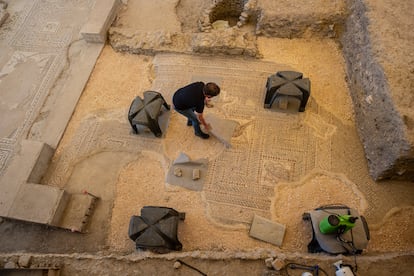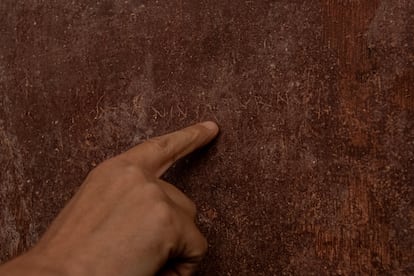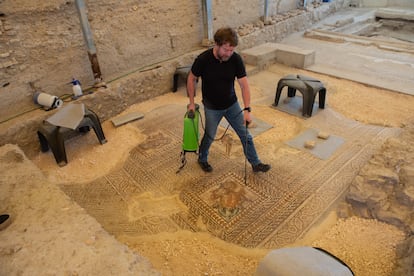Let’s put it in context: pivotal years between the 2nd and 3rd centuries. It is the great moment of the rich oil merchants, the oil of Antiquity, supplied to the all-powerful Roman army exclusively from Astigi, in the heart of Baetica, the Roman name for Écija, a Sevillian town on the border with Córdoba. It is also the golden age of the potters, who created, in the heat of demand, an industrial pole that extended uninterruptedly from Écija to Palma del Río, almost 30 kilometers of kilns where they did not stop making pots to be able to transport the green gold, non-returnable containers that today are distributed around the world to show the dimension of this industry. On Mount Testaccio in Rome alone it is estimated that there are – in the least optimistic calculation, according to archaeologists – between 75 and 80 million amphorae with the Astigitan seal.
“But in Egypt, in the port of Berenice, in the Red Sea, there are amphorae from Écija, even in India oil vessels from here have been found, apart from, of course, thousands in the north of England, throughout the Mediterranean…”, assures the head of the municipal archeology office of Écija, Sergio García-Dils, director of the latest excavations in collaboration with the Autonomous University of Barcelona. In that environment, a new aristocracy began to flourish, more like the upper bourgeoisie, linked to the oil trade, which became superlatively rich: the Fabio Poliones.
“It is a type of trade that drains money because it takes a lot of people. To produce oil you have to collect the olives, press them, then there is the transportation, the packaging in pottery… Even those who carry the firewood, because this requires tons to cook the amphorae,” says García-Dils, who justifies that this family, which dates back several generations, has not gone down in history because “with the Roman mentality, trade is not prestigious.” “In Rome the prestige is not to give a damn,” he smiles. What they called the leisure with dignity: leisure with dignity, dedicating yourself to thinking and little else.
Even so, the Fabios Poliones, “the aristocracy of Baetica that became rich with oil,” the archaeologist specifies, end up having so much influence “that they are the ones who end up appointing emperors like Trajan and Hadrian.” “The key to the success of the Roman Empire is its capacity for integration, to such an extent that the aristocracies here ended up ruling, they had a lot of hand in Rome.”
EL PAÍS has entered with García-Dils into one of the latest excavations – after the superlative finds at the beginning of the 21st century in the center of Écija – on the other side of the city, where two formidable mansions belonging to the Fabio Poliones have been located. “There comes a time for the rich classes and the aristocracy when they no longer want to live in the forum. As is happening now, they move to the outskirts,” says the archaeologist. The latest discovery has been a mosaic of more than 27 square meters, whose quality and conservation defy the expectations of archaeologists themselves. Excavated this summer, it offers a unique window into the customs and wealth of provincial Roman aristocracies. The most interesting thing for the scientific team is that, “from the names of those who lived here, we know that they are local people.” “The Fabios Poliones are Turdetan families (pre-Roman Hispanic people). Local aristocracies that collaborate with Rome and, therefore, come to have the status of Roman citizens.”

The archaeological treasure, which has been recovered in 60% of its original surface, corresponds to the pavement of what was the oecus of the palatial home—approximately 1,200 square meters—built on two levels. This dining room-reception stands out not only for its size, but also for its complex decoration. García-Dils takes a hose and pours water over the dusty tile motifs. Suddenly, once the dust and shine were removed—to show how rich they were, the tesserae were made of colored glass and not stone—the color and exquisiteness of the representations left no room for anything other than amazement.
The uniqueness of the mosaic also lies in its iconography. In its center there is a meander of swastikas, responsible for delimiting eight independent boxes. In four of them allegories of the seasons are reproduced, and in the remaining, wonderful scenes of birds, among which a partridge and a pair of pheasants predominate.
“It was also a way to flaunt their wealth,” explains García-Dils. And he points out a splendid mosaic right next to the newly discovered one, found in the middle of the pandemic: “Here, for example, there is a hunting scene, which although it is made of a Christ, you can distinguish very well what they wanted to represent. It is a hunting scene of a fallow deer. It is very interesting because it gives you a lot of information. What does it tell you about daily life with a fallow deer here? The fallow deer is not an Iberian species, but was introduced by the Romans only to hunt her So that is clearly to say, hey, I have fallow deer,” the archaeologist explains with amusement.
In another room of the mansion, perhaps the most surprising mosaic also appeared a few years ago—“it became very famous, it had a tremendous impact”—. One of the five that exist in the world with double reading. If viewed from one side he is a young satyr and, if viewed from the other side, he is a silenus (a larger character, a member of Bacchus’s entourage). Only three like this are known in Italy, one in Luxembourg and this one.
Now around 40% of the total palatial house has been excavated. And more surprises are expected: “It’s obvious, everything that comes out is brutal.”
The graffiti of the Saturnino boy
It is also awaited with great expectation what the manor house, “much richer than this one, for sure”, can offer from another member of the Fabios Poliones who has been located right next door. “A street separated them.” The archaeological works are carried out thanks to an agreement between the City Council of Écija and the University of Bologna, but they are still in an embryonic state. In any case, the little that can already be seen is astonishing, stuccoed walls with the polychrome intact. And a detail, minor, but attractive: a scratch on the wall where you can perfectly read a name: Saturnino.

He was a boy, a member of the Fabio Poliones, who must have been around eight years old when he wrote his name, in all the letters, scratching the wall of his bedroom, today baptized as the Domus II. “It was very common for children to learn by writing on the walls, as they do today to the horror of their mothers,” García-Dils jokes. Another sign of distinction, education. “In the Fabios Poliones it is certain that they were all literate, but, in general, as we see from graffiti of all kinds, it was already a fairly literate society at all levels.”

